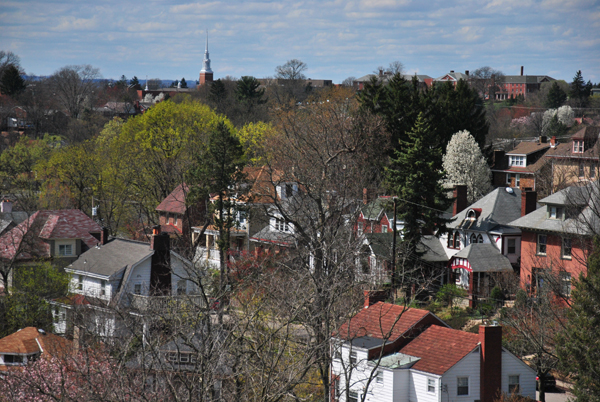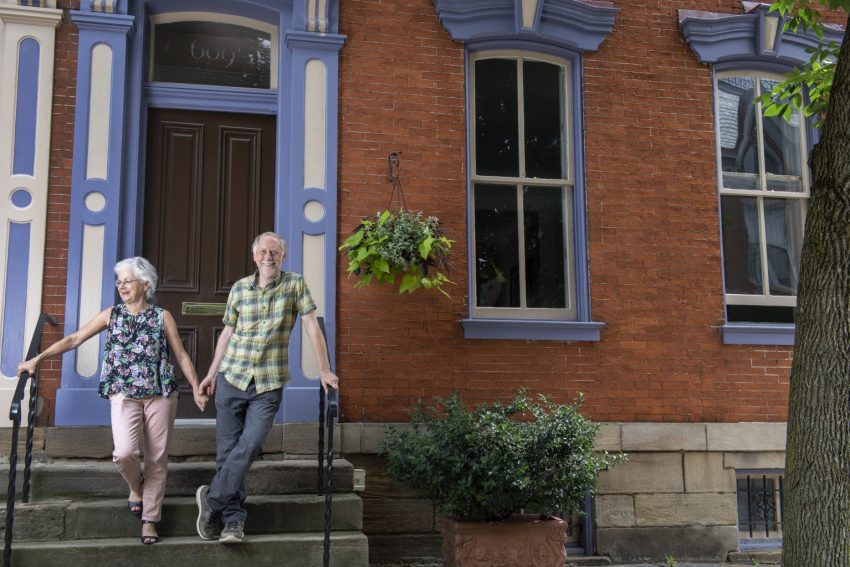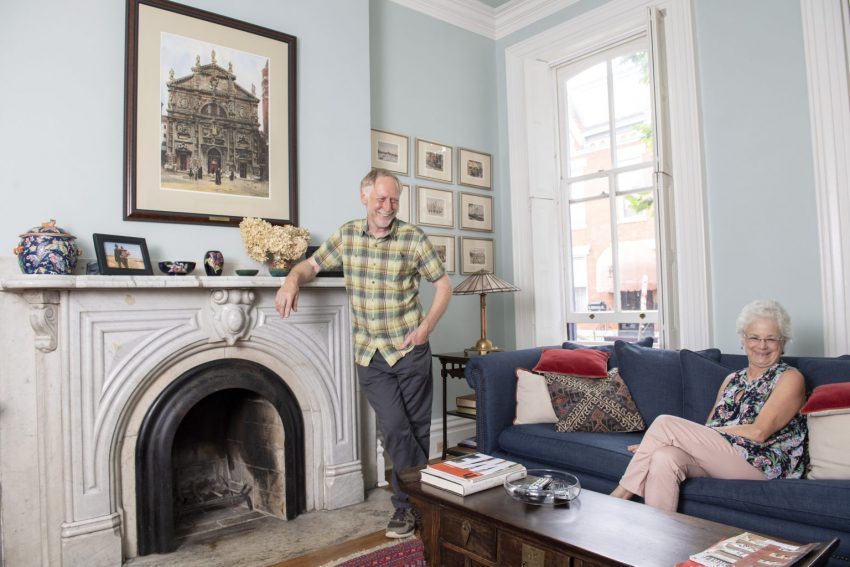
Category Archive: PHLF News
-
The Fine Foundation Awards Grant to PHLF
Thanks to funding support from The Fine Foundation, PHLF will be able to work with Manchester Academic Charter School teachers and students to create a permanent art display featuring Northside landmarks and local history for their new school that is scheduled to open in the spring of 2019 on the second-floor of the former Carnegie Library in Allegheny Center. In addition, SLB Radio will be able to install a “StoryBox” fixture so people can hear the voices of seven Northside celebrities whom the students interviewed in 2018.
This educational program helps fulfill the mission of The Fine Foundation by bringing together two focus areas within the Arts & Culture giving category––Art Education and the Visual Arts––and by making a positive difference in the lives of the MACS family. It builds on PHLF’s longtime involvement with the Northside community that began when the city was planning to demolish a row of historic houses on Liverpool Street (where MACS began and continues to have an elementary school).
Through “Our Northside Neighbors and Our New Middle School,” MACS students will develop more confidence in their artistic and writing abilities; be able to see the beauty of the built environment; develop a greater sense of belonging and feel part of the Northside story; and understand that historic places in their community can be inspirational sources for art and writing.
“We are grateful to The Fine Foundation for giving us the opportunity to work with MACS teachers and students in this creative project that builds pride of place and emphasizes the beauty and lasting community value of so many historic places on the Northside,” said Executive Director Louise Sturgess.
-
First-Ever “Architecture Day” in Oakland––Free For Architecture Enthusiasts of All Ages
Saturday, September 29, 201810:00 a.m. to 3:00 p.m. (stop by for any part of the day)Frick Fine Arts Building, University of Pittsburgh
650 Schenley Drive, Pittsburgh, PA 15260
Join Pittsburgh’s Architecture Learning Network (ALN) for the first ever “Architecture Day” on Saturday, Sept. 29 from 10:00 a.m. – 3:00 p.m. at the Frick Fine Arts Building. Learn about architecture educational programs throughout the Pittsburgh region for people of all ages; view architectural work on exhibit; and participate in discussions, workshops, and building tours.PHLF, an ALN partner, and other non-profit organizations will host free hands-on activities and exhibits in the first-floor gallery of the Frick Fine Arts Building and will offer a walking tour of the Oakland Civic Center (see below).
Architecture DayHosted by the Architecture Learning NetworkFrick Fine Arts Building, University of Pittsburgh650 Schenley Drive, Pittsburgh, PA 15260Saturday, September 29, 2018AGENDA10:00 a.m. – 3:00 p.m.Architecture Exhibit and Table Activities Hosted by ALN Partners––PHLF, UPitt, CMU, Fallingwater, YPA (morning), ACE, AIAS/Freedom By Design10:00 a.m. – 12:00 Noon- Panel Discussion, Where is Architecture in Pittsburgh?
- K-5 Grade Workshop, Fallingwater’s Gnome House Design Challenge
- K-5 Grade Workshop, Carnegie Mellon School of Architecture/UPitt, Building Up!
- PHLF Walking Tour, Oakland Civic Center (Advance reservations are required: marylu@phlf.org; 412-471-5808, ext. 527. Each tour is limited to 15 people.)
1:00 p.m. – 3:00 p.m.- Panel Discussion, How Sustainable is Pittsburgh?
- 6-12 Grade Workshop, Carnegie Mellon School of Architecture/UPitt, Analogue and Digital Media.
- 6-12 Grade Workshop, Fallingwater: Art of Design.
- PHLF Walking Tour, Oakland Civic Center. (Advance reservations are required: marylu@phlf.org; 412-471-5808, ext. 527. Each tour is limited to 15 people.)
Please come! -
“Right-Sizing” Is Not the Answer to the Challenges of Our Cities
By Arthur Ziegler
President, PHLF“We don’t know the future; Rust Belt Cities need to stop planning that there isn’t one.”
I recently saw this headline in an article on the web news magazine CityLab, and I was immediately reminded of what seems to me to be a misguided idea of people who are involved in urban planning, and even in historic preservation, that cities can be “right-sized.” Talk about a top-down strategy to excuse or as they often call it “manage decline.” What is the right size for Youngstown or Manhattan?
In the United States there are a series of major cities that are attracting young people, tech firms, advanced medical research, and lots of businesses providing jobs and a good quality of life. Has anyone done a study of what those cities share in common in the form of job creation, de-regulation, openness and diversity, public amenities, taxation, and what the Rust Belt cities share in common, and then look at the two groups for differences?
I have also noticed the trend where we have started calling rust belt cities “legacy cities,” and the primary subject does seem to be managing decline. We do have abundant evidence that retaining historic neighborhoods is one of the prime ingredients to attracting people into a city to live, to visit, and to hold on to the people who currently live there.
We preservationists should be arguing positively for appropriate changes in our cities that will make them attractive rather than giving up on large portions of our cities. Fortunately, the latter has been limited in Pittsburgh, but if you look at every neighborhood that has been subject to significant demolition and compared it to the historic neighborhoods where preservation was the fundamental ingredient in continuing to make our city attractive, you will see ample evidence that the “giving up” attitude of those who want demolition is harming the future of those cities.
In the CityLab article, Jason Hackworth of the University of Toronto, said that “this wave of destruction has not lead to market rebound or a decrease in social marginality. Those Rust Belt neighborhoods with the most disassembly since 1970 didn’t get better—they got worse.” Meanwhile, Alan Mallach, a scholar who was converted from the demolition approach, noted that “demolishing a lot of houses might be removing that neighborhood’s chance to survive in the future.” I certainly agree with him.
We preservationists should believe in the values of the architecture of our historic cities and encourage change and updating in other ways to compete nationally. Based on careful sensitivity to what is working elsewhere and to the great architectural treasures that we have can build new vibrancy. There is a bright future for rust belt cities, but we must begin with believing that to be true, and then we must have optimism and work towards utilizing the architectural legacy of these cities. Luckily Pittsburgh is doing that.
-
Audio-Recordings Describe People, Places, and Changes on the Northside

During a full-day program with PHLF on May 7, 2018, sixth-grade students from Manchester Academic Charter School explored several historic Northside places that have been adapted for new uses, and they also interviewed seven people who live and/or work on the Northside. SLB Radio recently produced audio-recordings based on those interviews.
Click here to listen to the stories of seven people who live and work on the Northside: Amber Farr, Director of One Northside, The Buhl Foundation; Bill and Kim Gandy, Curators, Allegheny City Historical Gallery; Faith Miller, Human Resources Coordinator, Children’s Museum of Pittsburgh; JuWanda Thurmond, Human Resources & Volunteer Coordinator, Children’s Museum of Pittsburgh; Karamagi Rujumba, Director of Development & Communications, PHLF; Mace Porac, PHLF docent; and Mark Fatla, Executive Director, Northside Leadership Conference.
Sixth-grade students from Manchester Academic Charter School interviewed these Northsiders during a special field trip and program PHLF planned for them on May 7, 2018, in cooperation with SLB Radio and the Children’s Museum of Pittsburgh. The students learned more about the history of the Northside and how it has changed over the years, in preparation for their move to their new middle school in the former Allegheny Regional Library in 2019.
PHLF thanks the McSwigan Family Foundation for supporting its educational programs that help young people explore their community, develop a sense of pride and belonging, and become active citizens.
-
Mt. Lebanon Design Guide Is Helpful to Homeowners Throughout the Region

Mt. Lebanon, incorporated in 1912, includes a two-square-mile National Register Historic District that was listed in 2014. More than 4,000 properties constructed before 1945 are included in one of the best-preserved early-automobile suburbs in the nation. Photo courtesy of the Municipality of Mt. Lebanon.
Click here to see an on-line Design Guide developed for Mt. Lebanon’s National Register Historic District that is also a great resource for homeowners throughout the city. Many historic styles detailed in the Design Guide can be found in other Pittsburgh neighborhoods. The Design Guide provides overviews of historic and post-war architectural styles, as well as basic exterior home maintenance. The maintenance portion of the guide is organized by specific projects that homeowners might undertake, making the guide user-friendly and easy to refer to only applicable sections.
This guide expands upon voluntary guidelines developed in 2016 by T&B Planning at the request of residents of Virginia Manor, one of the neighborhoods in Mt. Lebanon’s National Register Historic District. Once those guidelines were completed, it became clear that the information would be helpful to residents throughout Mt. Lebanon who want to preserve and enhance their historic homes.
Nicole Kubas, an urban design consultant, created The Design Guide in collaboration with the Mt. Lebanon Historic Preservation Board and the Mt. Lebanon Public Information Office. Nicole also is a PHLF member who participates in many of our walking tours and assists with our middle and high school architectural design challenges and apprenticeship.
-
Calvary Episcopal Church Special Event Combines Public Tours, Art, Architecture, and Music
Sunday, October 7, 2018
- 4:00 PM: Docent-led tours begin
- 5:00 PM: Choral Evensong
- 6:00 PM: Chatham Baroque Performance
- 6:30 PM: Reception in Parish Hall

Calvary Episcopal Church at Shady Avenue and Walnut Street in Shadyside. Photo courtesy of Steel City Drones.
PHLF members and friends are invited to a free event on Sunday, October 7, from 4:00 to 7:00 p.m. at Calvary Episcopal Church, 315 Shady Avenue, Pittsburgh, PA 15206. The church, designed in 1905-07 by Boston architect Ralph Adams Cram, is listed on the National Register of Historic Places. The program will help participants appreciate how Cram wove his ideas of space, sound, and ceremony into his buildings. Reservations are not needed.
Cram’s architecture is well known in the Pittsburgh region. In addition to Calvary, he designed First Presbyterian Church (1913-19) in Greensburg; Holy Rosary Roman Catholic Church (1926-31) in Homewood; and East Liberty Presbyterian Church (1930-35). First Baptist Church (1909-12) in Oakland was designed by Cram’s firm and partner, Bertram Grosvenor Goodhue.
Calvary Episcopal Church will be open on Sunday, October 7 for docent-led tours between 4:00 and 5:00 p.m., followed by two brief musical performances: the Calvary Choir will present a service of Choral Evensong, and Chatham Baroque and Alan Lewis, Calvary’s Music Director, will present a brief concert to celebrate Calvary’s new harpsichord. The evening will conclude with a sherry reception in the Parish Hall.
This program is a unique opportunity to experience the way in which Ralph Adams Cram expressed his architectural ideas through music and liturgy. After seeing the architectural features of the church during the docent-led tours, guests will be able to reflect on these ideas while listening to the music of the Choral Evensong service. Choral Evensong––evening prayer in song––is heard in English Cathedrals and collegiate churches such as Cambridge and Oxford at the evening hour. The Calvary Choir is one of the foremost Episcopal church choirs in the country, regularly performing at Cathedrals and churches in Washington and New York.
The program is free and open to the public. The Reverend Jonathon Jensen is Rector of Calvary Episcopal Church and Dr. Alan Lewis is Director of Music.
-
Thank You, Summer Interns

Amanda Seim, Lauren Jasper, and Maria Brown volunteered with PHLF’s education department this summer.
Three talented young people––Maria Brown, Lauren Jasper, and Amanda Seim––volunteered with PHLF’s education department this summer, assisting especially with tours, presentations, and publications.
“Maria, Lauren, and Amanda offered important edits to our new guidebook, Exploring Pittsburgh: A Downtown Walking Tour, and constructive feedback on our Free Friday Walking Tours. In addition, Amanda created and led a neighborhood walking tour of East Liberty and Lauren and Maria planned and developed materials for a new school tour featuring a group of Pittsburgh places named for famous people,” said Executive Director Louise Sturgess. “We were able to accomplish so much more with their help, and we thank each of them for spending time with us.”
Maria, Lauren, and Amanda added these comments about their experience with PHLF during the summer of 2018:
Through my time going on tours, assisting in the development of a new tour, and producing and editing written works, I acquired skills useful for my career path and knowledge about Pittsburgh’s history and architecture. I also gained an understanding of what kind of place Pittsburgh is for its people and how those people will create and protect their city, my new home. Thank you PHLF for the privilege and experience of being a summer intern! ––Maria Brown (Davidson College, English)
This summer, I gained a new level of understanding about the city that I love. As an aspiring architect, it was great for me to learn about the characteristics that make Pittsburgh buildings unique and beautiful. –– Lauren Jasper (The Ellis School)
My experience at PHLF has really impressed me with how important educational programming is in bringing local history to life and instilling community pride. I’ve been able to see firsthand that once people know more about the history in their surrounding environment, they care more about it. ––Amanda Seim (Duquesne University, Public History)
-
Good Luck and the Ability to Take Risks: A Story of Preservation

Clare and Duncan Horner, standing outside their house at 609 Taylor Avenue, in the Mexican War Streets on the North Side of Pittsburgh.
By Christine McClure, PHLF member and volunteer writer
When Clare and Duncan Horner met in England in the early 1970s, Clare was part of an exchange program in social history at Warwick University through the University of Pittsburgh. Duncan was also a Warwick University student and former apprentice compositor who had attended Ruskin College in Oxford.
They both discovered that they had an interest in old buildings and architecture. “The old appealed to me,” said Clare. Duncan grew up in the eastern suburbs of London.
“I don’t think of the 19th century as historic,” he laughed as he recalled. “Where I grew up, the village church predated the Norman Conquest!”
Clare and Duncan married in 1973 and moved to Pittsburgh, where Clare finished her Doctor of Philosophy degree in history.
When they went looking for an apartment, they found one on Resaca Place in the Mexican War Streets on the North Side, in an old house built in the 1880s. The Pittsburgh History & Landmarks Foundation (PHLF) was just starting to renovate the area.
Duncan remembers that the house had some nice architectural features, but it needed work. “We walked in and said ‘We’ll take it!’.”
After they were given a one-year lease, Duncan asked if he could do some renovating. The landlord agreed, so Duncan enlarged the windows in the back-dining room and repaired the uneven flooring. Soon, he became quite adept at renovation and neighbors started requesting his skills and services for their homes.

Clare and Duncan married in 1973 and moved to Pittsburgh, where Clare finished her Doctor of Philosophy degree in history.
When a row house around the corner at 609 Taylor Avenue became available—part of four row houses that PHLF had purchased, cleaned the surface, and protected windows with plywood— Duncan set up a meeting with Arthur Ziegler, president of PHLF, to negotiate a price for the house.
The Horners secured a mortgage and Neighborhood Housing Services provided a loan to help with improvements on the house, which had a roof that had fallen-in on the back end of the house.
While Duncan worked on the house, Clare completed her Ph.D. from the University of Pittsburgh, and went on to law school. Along the way, they had two daughters.
By this time the house had gone from two-and-a-half stories (the top was an attic) to four stories, including a finished basement and a widened dormer on the attic to accommodate a deck, larger windows, and a door leading out to the deck.
The summer of 1988 was an unusually hot one, with temperatures climbing to 100 degrees on several days. They started looking for a summer place which had a stream or a public pool nearby where the girls could swim and play and they could escape the heat.
They found it in Greene County. Clare spotted a small for sale sign on some land off of the main road. There was a stream, a small bridge which had been built by the Works Progress Administration during WWII, and a state park with a swimming pool that bordered on the property.
The Horners signed a land sale contract (common in rural areas), which allowed them to pay a small monthly payment for three years, after which they had to pay the balance of the sale price. The property – homesteaded in 1834 and owned by a prominent local family, the Chesses – had a house, a milk shed, two barns (grain and dairy), a chicken coup, root cellar, outhouse and a smoke house. Clare and Duncan removed several of the outbuildings and made one building into a playhouse for their girls.
Since the Chess family had owned the property for 100 years, Helen Chess Levander, the last of the Chesses to own the property, received a Pennsylvania century form, a certificate issued by the Commonwealth of Pennsylvania. The Chess family gave 30 acres to the state park in 1960, but their family cemetery is still on the park land. One of Helen’s nephews still lives across the road from Clare and Duncan.
In 2004, the Horners attended a special presentation at the Heinz Architectural Center, where Jack Miller, then director of gift planning at PHLF, spoke about saving historic farms through creative planned gift strategies.

Duncan Horner seen here at their 1800s-era farmhouse located on 70-acres of land protected through a preservation easement donated to PHLF.
As a result, in 2006, the Horners sold PHLF a preservation easement on their mid-19th-century, 70-acre farm and then re-financed the property to make a tax-deductible gift to PHLF to endow the easement.
An easement is a voluntary legal agreement that is recorded in the local recorder of deeds office and, once established, binds both the current owners and all future owners.
PHLF inspects its preservation easements on at least an annual basis and has a responsibility to defend and enforce the preservation easement as may be necessary.
Over the years, the couple bought five other homes in the Mexican War Streets Historic District, four of which they rented out. They received awards from the City of Pittsburgh for two of their restorations.
When asked if they have any advice for people buying historic properties, Duncan says; “Try to do as much of the renovation as you can. Be willing to take risks, be a little impulsive, and have faith in the future.”
They have since sold all but one house in the Mexican War Streets; that house is owned by one of their daughters.
Both the Horners’ daughters are interested in historic preservation. “The preservation tradition goes on,” said Clare.

